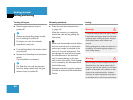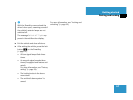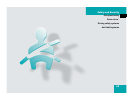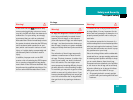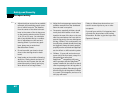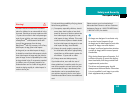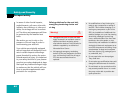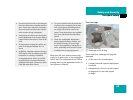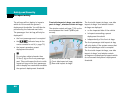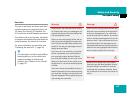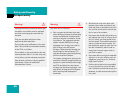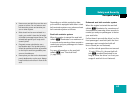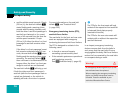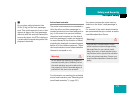
64
Safety and Security
Occupant safety
Safety guidelines for the seat belt,
emergency tensioning device and
air bag
In cases of other frontal impacts,
angled impacts, roll-overs, other side
impacts, rear collisions, or other acci-
dents, the air bags will not be activat-
ed. The driver and passengers will then
be protected by the fastened seat
belts.
We caution you not to rely on the
presence of the air bags in order to
avoid wearing your seat belt.
Your vehicle was originally equipped
with air bags that are designed to acti-
vate in certain impacts exceeding a
preset threshold to reduce the poten-
tial and severity of injury. It is important
to your safety and that of your passen-
gers that you replace deployed air bags
and repair any malfunctioning air bags
to make sure that the vehicle will con-
tinue to provide supplemental crash
protection for occupants.
Warning! G
ț Damaged seat belts or belts that were
highly stressed in an accident must be
replaced and their anchoring points
must also be checked. Only use belts in-
stalled or supplied by an authorized
Mercedes-Benz Center.
ț Air bags and emergency tensioning
devices (ETDs) are designed to function
on a one-time-only basis. An air bag or
ETD that was activated must be
replaced.
ț No modifications of any kind may be
made to any components or wiring of
the SRS. This includes changing or re-
moving any component or part of the
SRS, the installation of additional trim
material, badges, etc. over the steering
wheel hub, passenger front air bag
cover, outboard sides of the front seat
backrests, door trim panels, or door
frame trims, and installation of addition-
al electrical/electronic equipment on or
near SRS components and wiring. Keep
area between air bags and occupants
free from objects (e.g. packages, purs-
es, umbrellas, etc.).
ț Do not pass belts over sharp edges.
They could tear.
ț Do not make any modification that could
change the effectiveness of the belts.
ț Do not bleach or dye seat belts as this
may severely weaken them. In a crash
they may not be able to provide ade-
quate protection.



